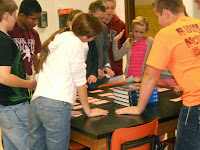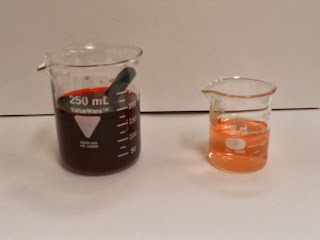 |
| On it's way up. |
On Tuesday students were given the study guide for the test. But first we reviewed colloids by making some samples of oobleck and goop/gak/flubber.
 |
| Oobleck ingredients - cornstarch and water. |
We used the ratio of approximately 2 cornstarch to 1 water. This creates a non-Newtonian liquid that becomes solid under pressure. To see oobleck dancing watch this video.
To see it on the Ellen DeGeneres Show watch this video.
Ingredients for goop/gak/flubber consist of water, borax and glue.
My recipe calls to make a solution of the white glue and water with a ratio of 1:1. An a borax solution (really a suspension as it settles out) at a ratio of 8:1. In this case the water is the solvent (large amount) and the borax is the solute (small amount).
We measured out equal amounts of each solution.Then combined them and stirred, creating a chemical change and producing this. Another recipe and video is located here.
 |
| Which one? |
 |
| A correct set. |
 |
| I don't think so. |





















